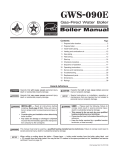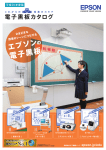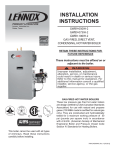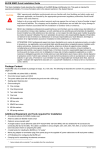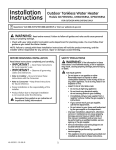Download GWS - Venting - Williamson
Transcript
GWS Gas-Fired Water Boilers Venting Manual (Also includes GWS-090E) Hazard definitions Hazards that will cause severe personal injury, death or substantial property damage. Hazards that can cause severe personal injury, death or substantial property damage. Hazards that will or can cause minor personal injury or property damage. Special instructions on installation, operation or maintenance that are important but not related to personal injury or property damage. Venting method definitions Direct vent — Uses outside combustion air with combustion air connector piping sealed at all joints and seams. Also known as “sealed combustion”. All GWS and GWS-090E flue gas vents are pressurized, requiring careful sealing of all joints. Direct exhaust venting — Uses inside combustion air with no combustion air connector piping. All GWS flue gas vents are pressurized, requiring careful sealing of all joints. Also known as “non-direct venting”. (DO NOT apply direct exhaust venting to GWS-090E boilers — they must be direct vented only.) Chimney draft venting — Uses the natural draft provided by a vertical vent or chimney. (This method cannot be used with GWS boilers.) Chimney draft venting cannot be used for GWS or GWS-090E boilers. Vent system must be constructed only using venting materials listed in this Venting Manual. Existing vertical vents or chimneys may only be used as raceways for routing vent or vent/air piping as described in this Venting Manual. This Venting Manual must only be used by a qualified installer/service technician. Read these instructions completely before beginning the installation. Failure to follow all instructions in proper order can cause severe personal injury, death or substantial property damage. To install a new vent system follow instructions in: • This Venting Manual • GWS or GWS-090E Boiler Manual • Vent pipe manufacturer’s instructions supplied with vent material. DO NOT apply direct exhaust venting for GWS-090E boilers. These boilers must only be installed as direct vent. Contents Page 1 Determine venting method.........................................2 2 Combustion air supply................................................3 3 Obtain vent system components................................4 4 Install vent starter.......................................................6 5 Vent termination.........................................................7 6 Direct exhaust — Vertical and sidewall venting..........8 7 Direct vent — Sidewall venting.................................10 8 Direct vent — Vertical venting..................................12 INSTALLER — Read all instructions before installing. Follow all instructions in proper order to prevent personal injury or death. Boiler must be vented and supplied with combustion air as described in this manual. Failure to do so will result in severe personal injury, death or substantial property damage. Use only the sealant specified by the vent pipe manufacturer, applied per their instructions. Vent piping must be sealed gas-tight to prevent possibility of flue gas spillage and carbon monoxide emissions, resulting in severe personal injury or death. Provide combustion and ventilation air openings as described in the GWS or GWS-090E Boiler Manual. Failure to provide adequate air supply could result in severe personal injury, death or substantial property damage. USER — Please read the following. Failure to comply could result in severe personal injury, death or substantial property damage. • This manual is for use only by your qualified heating installer/service technician. • Please see the User’s Information Manual for your reference. • We recommend regular service by a qualified service technician, at least annually. Part Number 550-110-734/1108 GWS Gas-Fired Water Boilers – Venting Manual 1 Determine venting method To prevent potential of severe personal injury or death, check for areas and products listed in Table 1, page 3, before installing boiler. If found, either remove products permanently or provide outside combustion air (direct vent installation). Direct exhaust venting Direct venting Use only when openings for inside combustion air can be supplied in accordance with the GWS or GWS-090E Boiler Manual, this venting manual and with all applicable codes. You must direct vent the boiler if the boiler area may contain contaminants as described in this manual. Two direct exhaust vent options are permitted: sidewall and vertical, per instructions in this manual. See Figure 1, items 1 and 2. Install an elbow on the air intake fitting as shown in illustrations in this Venting Manual. This will help prevent accidental blockage of the air intake. Combustion air is provided by air piping connecting from the boiler air intake fitting to the outside. You must direct vent the boiler (pipe outside air to boiler air intake fitting) if the boiler area may contain contaminants as described in this manual. Two direct vent options are permitted: 1. Direct vent sidewall — using Vent/Air Intake Termination Kit. See instructions in this venting manual. Termination kit is included with GWS or GWS-090E boiler. See Figure 1, item 3. 2. Direct vent vertical — using Through-Roof or Through-Unused-Chimney Termination Kit. See Figure 1, item 4. Do not apply to GWS-090E boilers. GWS-090E boilers must be direct vented. All GWS-090E boilers must be direct vented (not direct exhaust). Figure 1 Venting methods Do not apply direct exhaust to GWS-090E boilers. GWS-090E boilers must be direct vented. 2 Part Number 550-110-734/1108 GWS Gas-Fired Water Boilers – Venting Manual 2 Combustion air supply Please review the following information on potential combustion air contamination problems. Refer to Table 1 for products and areas that may cause contaminated combustion air. These contaminants may cause damage to the vent piping, and must be eliminated from the boiler combustion air supply. You may do this by removing the contaminants permanently from the area or piping air directly to the boiler (direct vent) using one of the methods described in this manual. If the boiler is installed in any area likely to cause contamination, or if products which would contaminate the air cannot be removed, you must pipe combustion air to the boiler air intake. Contaminated combustion air will damage the boiler, resulting in possible severe personal injury, death or substantial property damage. Do not install a GWS boiler in a laundry room or pool facility, for example, without using ducted outside air. These areas will always contain contaminants. Table 1 Corrosive contaminants Products to avoid Spray cans containing chloro/fluorocarbons Permanent wave solutions Chlorinated waxes/cleaners Chlorine-based swimming pool chemicals Calcium chloride used for thawing Sodium chloride used for water softening Refrigerant leaks Paint or varnish removers Hydrochloric acid/muriatic acid Cements and glues Antistatic fabric softeners used in clothes dryers Chlorine-type bleaches, detergents, and cleaning solvents found in household laundry rooms Adhesives used to fasten building products and other similar products Areas likely to have contaminants Dry cleaning/laundry areas and establishments Swimming pools Metal fabrication plants Beauty shops Refrigeration repair shops Photo processing plants Auto body shops Plastic manufacturing plants Furniture refinishing areas and establishments New building construction Remodeling areas Garages with workshops Part Number 550-110-734/1108 3 GWS Gas-Fired Water Boilers – Venting Manual 3 Obtain vent system components Vent and air components 1. The following special gas vent systems comply with UL-1738 and ULC-S636 standards and are certified by CSA as the only systems suitable for use with GWS and GWS-090E boilers. Use only 3” vent piping from following: • Heat-Fab, Inc. Saf-T Vent® • Flex-L International, Inc. StaR-34 • Z-Flex®, Inc. Z-Vent II • ProTech Systems FasNSeal™ Use only the vent starter of the same manufacturer as the vent components. Do not mix components from different systems. The vent system could fail, causing flue gas spillage, resulting in severe personal injury or death. 2. Use suitable 3” material for combustion air connector piping, such as: Table 2 Direct exhaust and sidewall direct vent maximum vent length Maximum vent length (feet) Total number of elbows (Notes 1– 3) 1 2 3 4 5 6 GWS-063, -095 & GWS-090E 55 48 41 34 27 20 GWS-127 & GWS-158 45 38 31 24 17 10 Notes: 1. Do not include termination fitting when counting total number of elbows. 2. One (1) 90° elbow equals two (2) 45° elbows. 3. GWs-090E can only be direct vented. • Dryer vent • Galvanized steel • PVC (3” I.D.) Direct exhaust and Direct vent sidewall 1. Select vent method based on page 2 and installation requirements. 2. Refer to Table 2 for maximum vent run lengths and number of elbows. Do not exceed data in Table 2. 3. Select vent components from separate GWI and GWS Vent Component Supplement. All components, including the vent starter, must be of the same vent manufacturer. Do not mix components. 4 Part Number 550-110-734/1108 GWS Gas-Fired Water Boilers – Venting Manual 3 Obtain vent system components Direct vent vertical 1. The Through-Roof or Through-Unused-Chimney Termination Kit, part number 382-200-436WT, provides special parts required to route 3-inch stainless vent pipe through 5-inch B-vent. The space between the vents provides the passage for combustion air. See Figure 3 for parts included with the kit. 2. Verify that the vent termination will comply with the requirements listed on page 7. Then verify that the vent and air piping will not exceed the length limits given in Section 8, page 12 of this manual before locating boiler or floor/roof penetrations. 3. You will need to obtain stainless vent pipe and fittings, using only the vent systems listed in separate GWI and GWS Vent Component Supplement. Also obtain B-vent pipe and fittings for the vertical run and floor/roof penetrations (See Table 3). continued Figure 3 Vertical direct vent — Parts provided in Through-Roof or Through-Unused-Chimney Termination Kit (part number 382-200-436WT) Figure 2 Vertical direct vent — Typical installation, showing component identification 1 2 3 4 5 6 7 8 Tee, galvanized 5” x 5” x 3” — qty: 1 Vent clamp — qty: 5 Bottom cap, galvanized with 4½” hole — qty:1 Vent support — qty: 1 Elastomer grippers — qty: 11 Screws, sheet metal, type A, #10 x 1¼” — qty: 11 Screws, sheet metal, type A, #10 x ½” — qty: 3 Elastomer flashing — qty: 2 Table 3 Vertical direct vent — Parts required but not provided in kit (provided by installer, see Figure 2) Description Rain cap, galvanized, 5” Adjustable flashing, type B, 5” Fire stop for each floor or attic penetration Storm ring, type B, 5” Support, type B, 5” Draft hood connector, type B, 5” Adequate B-Vent with clamp rings for combustion air run (less than 30 feet) Adequate 3” vent material for vent run and elbows from one of the following (See Note): • Heat-Fab, Inc. — Saf-T Vent® • ProTech Systems — FasNSeal™ • Flex-L International, Inc. — StaR-34 • Z-Flex®, Inc. — Z-Vent II Adequate sealant specified by vent pipe manufacturer’s instructions Quantity 1 1 1 1 1 1 --- -- -Adequate 3” PVC, galvanized or dryer vent (for combustion air supply piping between tee and boiler) Note: Do not mix types of vent material. CSA certification will be void. Part Number 550-110-734/1108 5 GWS Gas-Fired Water Boilers – Venting Manual 4 Install vent starter Use only the vent starter of the same manufacturer as the vent components. Do not mix components from different systems. The vent system could fail, causing flue gas spillage, resulting in severe personal injury or death. 1. Select a vent pipe manufacturer and obtain all vent components needed, based on boiler location and venting method. 2. You must use the vent starter made by the vent pipe manufacturer. See GWI and GWS Vent Component Supplement, for part number of each component, listed by vent manufacturer. 3. Follow all applicable national, state, local or provincial codes when venting the GWS boiler. 4. Connect vent starter to blower housing outlet as shown in Figure 4, below. a. Do not mix components from different vent manufacturers. b. Maintain minimum 2” clearance from combustible materials to vent pipe. (Exception: PVC air pipe can be no closer than 3/16” from the vent pipe, as dictated by the dimensions of the vent termination.) c. Seal with sealant specified by vent pipe manufacturer, using 3/8” bead (not required for FasNSeal™). d. Tighten strap at band clamp screw until strap is snug around blower housing. Figure 4 Vent starters 6 Part Number 550-110-734/1108 GWS Gas-Fired Water Boilers – Venting Manual 5 Vent termination Follow instructions on this page when determining vent location to avoid possibility of severe personal injury, death or substantial property damage. 1. Locate the boiler and vent penetration through the wall (Direct exhaust and Direct vent sidewall) or roof (Direct vent vertical) so all requirements on this page and in Figure 5 will be met. Also follow vent manufacturer’s instructions. 2. Gases will form white plume in winter. Plume could obstruct window view of nearby windows in multistory buildings. 3. Prevailing winds could cause freezing of condensate and water/ice buildup on vent termination, building, plants or roof. Ice buildup on vent termination can cause boiler shutdown and building freeze-up. 4. Direct exhaust — Winds over 31 mph can cause nuisance boiler shutdown if boiler is sidewall vented. This could result in loss of heat to building, causing freeze-up. 5. Locate or guard vent termination to prevent condensate from damaging exterior surfaces. 6. Locate the vent termination well away from trees, shrubs, and decorative items. 7. Locate or guard vent to prevent accidental contact by people or pets. 8. Do not terminate vent in window well, stairwell, alcove, courtyard, or other recessed areas. 9. Do not wrap or insulate vent pipe or fittings. 10.Direct exhaust and Direct vent sidewall: Do not terminate vent above any door or window. Condensate can freeze, causing ice formations. 11.Do not connect: • • Any other appliance to vent pipe. Multiple boilers to a common vent pipe. 12.Canadian installations — See B149.1 or B149.2 Installation Code. Terminate vent no less than 6 feet from another combustion air inlet, 3 feet from any other building opening, and 3 feet from any gas service regulator. 13.See Figure 5, showing that the vent must terminate: • • • • more than 1 foot (Direct vent) or 4 feet (Direct exhaust) below or to side of all doors or windows. more than 1 foot above grade or anticipated snow line. at least 7 feet above public walkway 3 feet above any forced air intake within 10 feet. 14.Vent must also terminate: • • • at least 6 feet away from adjacent walls. no closer than 5 feet below roof overhang. at least 4 feet horizontally (and in no case above or below unless a 4 foot horizontal distance is maintained) from electric meters, gas meters, regulators, relief valves, and other equipment. 15.Site conditions may dictate greater clearances. 16.Direct exhaust and Direct vent sidewall — Do not extend exposed vent pipe outside of building. Condensate could freeze and block vent pipe. A gas vent extending through an exterior wall shall not terminate adjacent to the wall or below building extensions such as eaves, overhangs, balconies or decks. Failure to comply could result in severe personal injury, death or substantial property damage. Figure 5 Sidewall Direct Vent or Direct Exhaust Vent — Vent termination minimum clearances Part Number 550-110-734/1108 7 GWS Gas-Fired Water Boilers – Venting Manual 6 Direct exhaust — Vertical and sidewall venting Do not apply to GWS-090E boilers. GWS-090E boilers must be direct vented. Installation guidelines Figure 6 Direct exhaust vertical or sidewall venting 1. Do not mix types or manufacturers of vent materials. 2. Clean all joints before sealing. See vent manufacturer’s instructions for cleaning and sealing joints. Use their specified sealant. Do not use screws. 3. Install vent pipe with seams on top of vent horizontal runs. Follow requirements on page 6 for vent termination. 4. Maintain minimum 2” clearance from combustible materials to vent pipe. 5. Vertical venting — See Figure 6. Follow vent manufacturer’s instructions for venting through roof (or unused chimney or vent as raceway). • • • Vent pipe must extend through roof flashing, jacket or thimble. Vent may pass through floor, inside wall or concealed space when installed according to vent manufacturer’s instructions. Vent may pass through an unused chimney or vent as a raceway if allowed by vent manufacturer and installed per vent manufacturer’s instructions. Sidewall venting — See Figure 7, page 9. Vent must terminate at least one foot above anticipated snowline. Vent must be terminated only with: • • Tee or elbow with integral screen. (Tee may be mounted either vertically or horizontally.) Elbow or termination coupling with screen (not available for StaR34). Install an elbow on the air intake fitting as shown in illustrations in this Venting Manual. This will help prevent accidental blockage of the air intake. 6. Sidewall venting — Do not seal vent pipe to inside or outside plate. 7. Sidewall venting — If passing through noncombustible wall, provide hole diameter large enough to insert the vent pipe. 8. Install horizontal drain tee as close as possible to boiler, in first horizontal run. See Figure 6. 9. Do not exceed the maximum vent system length given in Table 3 on page 4. Condensate drain line — use only silicone tubing rated for at least 400 °F for the first 18” of condensate drain line, then other non-metallic tubing may be used. Using any other material could cause flue gas leakage, potentially resulting in severe personal injury, death or substantial property damage. On some installations, the condensate drain fitting may be omitted, provided: • Vent manufacturer shows this option in their instructions. • Vent is sloped toward termination as shown in dotted lines in Figure 6. • The vent is installed per boiler manufacturer’s and vent manufacturer’s instructions. Condensate drippage from such vents may accumulate on the ground below. Consider traffic in the area to avoid hazard due to ice accumulation. 8 Part Number 550-110-734/1108 GWS Gas-Fired Water Boilers – Venting Manual 6 Direct exhaust — Vertical and sidewall venting cont. Do not apply to GWS-090E boilers. GWS-090E boilers must be direct vented. Figure 7 Direct exhaust sidewall venting termination Part Number 550-110-734/1108 9 GWS Gas-Fired Water Boilers – Venting Manual 7 Direct vent — Sidewall venting termination cap and outside plate with any exterior building material, such as siding or wood. Installation guidelines 1. Install vent and air piping in accordance with the GWS or GWS-090E Boiler Manual, this Venting Manual and with all applicable national, state, provincial and local codes. In Canada, see B149.1 or B149.2 Installation Code. 2. Do not mix types or manufacturers of vent materials. 3. Clean all joints before sealing. See vent pipe manufacturer’s instructions for cleaning and sealing joints. Use their specified sealant. Do not use screws. 4. Install vent pipe with seams on top of vent horizontal runs. Follow requirements on page 7 for vent termination. 5. Maintain minimum 2” clearance from combustible materials to vent pipe. Exception: PVC air pipe can be no closer than 3/16” from the vent pipe, as dictated by the dimensions of the vent termination. 6. See Figure 8. Vent must terminate at least one foot above anticipated snow line. 7. Install horizontal drain tee as close as possible to boiler, in first horizontal run. See Figure 8. 8. Do not exceed the maximum length given in Table 3, page 4, for either the vent pipe or the air pipe. Install Vent/Air Intake Termination Use this kit with wall thicknesses of 2 inches minimum, 24 inches maximum. 1. Refer to Figure 9 on page 11 for installation details. 2. Remove the sidewall vent kit box from boiler. The kit should include the following items: • vent termination cap • screws • aluminum inside plate • spacers • stainless steel outside plate • lockwashers • anchors for masonry walls 3. Sidewall venting can be installed with pipes side-by-side or on top of one another with vent pipe on top. Do not cover up vent 4. Cut a 5” x 8½” rectangular rough opening in inside and outside walls for vent pipe and, if used, combustion air pipe. Use paper template provided with kit. Sealant recommended by vent pipe manufacturer must be used as indicated in their instructions. Vent piping must be sealed gas-tight to prevent possibility of flue gas spillage and carbon monoxide emissions, resulting in severe personal injury or death. Follow vent manufacturer’s instructions for support of vent pipe. Do not support from termination kit. From outside the building 5. Install outside plate. 6. Loosely install vent pipe (with vent pipe termination in place) through the termination cap and outside plate. Do not connect pipe or seal to plate. From inside the building 7. Install spacers and sleeve (if passing through combustible wall). 8. Install inside plate. If used, feed combustion air pipe through inside and outside plates. From outside the building 9. Use termination cap to position combustion air pipe against stops on the inside of termination cap. 10.Seal outside plate to building. Seal around combustion air pipe. 11.Install termination cap. Set ¼” to ¾” space between outside plate and stop on vent pipe termination. From inside the building 12.Seal around air intake pipe on inside plate. 13.Complete vent pipe run to vent starter at boiler. (See page 11 for air piping instructions.) Figure 8 Direct vent sidewall venting termination 10 Condensate drain line — use only silicone tubing rated for at least 400 °F for the first 18” of condensate drain line, then other non-metallic tubing may be used. Using any other material could cause flue gas leakage, potentially resulting in severe personal injury, death or substantial property damage. Part Number 550-110-734/1108 GWS Gas-Fired Water Boilers – Venting Manual 7 Direct vent — Sidewall venting continued Sidewall direct-vented vent pipe must terminate with coupling as shown in Figure 9. Failure to do so could result in flue gas recirculation, with the potential of severe personal injury or death. If you remove the air piping from an existing direct-vented installation, to change to direct exhaust venting, you must replace the termination coupling with a down-turned termination elbow with screen or a termination tee with screen as shown in Figure 6, page 8 and Figure 7, page 9. Failure to do so could result in nuisance outages and loss of heat, with potential substantial property damage. Figure 9 Termination assembly Install combustion air piping Sidewall venting multiple GWS boilers 1. Seal all combustion air piping joints and seams, using sealant as below: Do not connect multiple boilers to the same vent. Failure to comply could result in severe personal injury, death or substantial property damage. 1. Space terminations apart as shown in Figure 10, below. a. Dryer vent — A piece of 3” galvanized is required at each end to adapt. Seal all pipe joints and seams between pipe and dryer vent with approved silicone sealant (see NOTICE below). b. Galvanized pipe — Seal all joints and seams using approved silicone sealant (see NOTICE below). c. PVC pipe — Seal all joints using PVC cement. Figure 10 Venting multiple GWS boilers Except where noted otherwise above, seal air piping using either the sealant specified by the vent pipe manufacturer for vent joints or one of the following silicone sealants: • Dow Corning 700™ or 732™ • General Electric 108 or 800 Support the air piping in the same manner as specified for the vent pipe by the vent pipe manufacturer. Do not support the air pipe from the sidewall termination. Part Number 550-110-734/1108 11 GWS Gas-Fired Water Boilers – Venting Manual 8 Direct vent — Vertical venting Installation guidelines 1. Codes — Install vent and combustion air piping in compliance with all applicable national, state, local or provincial codes. 2. Do not connect: • Any other appliance to combustion air or vent piping. • Any other appliance into or through chimney when using existing chimney as raceway. • Multiple boilers into common vent. 3. Vent length limits — Position boiler as close as possible to vertical vent/air run. Do not exceed vent length limits given in Section 8 of this manual. B-vent limit is 30 feet. Vent or air maximum lengths are: • GWS-063, GWS-095 & GWS-090E: Max 55 equivalent feet • GWS-127 & GWS-158: Max 45 equivalent feet 4. Materials and construction — • Seal all B-vent combustion air joints with approved silicone sealant (Dow Corning 700™ or 732™, General Electric 108 or 800, or sealant specified by vent pipe manufacturer. B-vent sections must be straight — no elbows. • Construct vent joints per vent manufacturer’s instructions, including use of their specified sealant. Vent pipe routed inside B-vent must also be fitted with vent clamps with elastomer grippers, installed per “Installation — Assembly”, pages 14 and 15 of this manual. • Use only one of the approved vent systems listed in Table 2, page 4. Do not mix types of vent material. CSA certification will be void. 5. Install boiler per GWS or GWS-090E Boiler Manual. Verify vent system length The vent or air piping must be no longer than the maximum value given in Tables 4 and 5. Note in the tables that the maximum length of connector piping (vent or air piping between boiler and B-vent tee connection) depends on the number of elbows and the length of the B-vent section. The reason is each 90-degree vent or air pipe elbow cause the same pressure drop as 7 feet of straight pipe. Vent/air piping length verification procedure: Step 1 — Determine dimensions of vent/air pipe needed for planned location Measure or calculate the vent/air pipe lengths required for the planned location of the boiler and floor/roof penetrations. See Figure 11 for a typical layout. • How long will the vertical B-vent section have to be? Round up to the nearest 5 feet (for example, if B-vent length needs to be 12 feet, round this amount up to the nearest 5 feet — use 15 feet for your B-vent length). (This is dimension L in Figure 11.) • How many elbows will be needed in the vent connector piping (from boiler to B-vent tee)? • How many feet of vent piping will be needed for the connector runs? (This would be the sum of dimensions C & D in Figure 11.) • How many elbows will be needed in the air connector piping (from boiler to B-vent tee)? • How many feet of air piping will be needed for the connector runs? (This would be the sum of dimensions A & B in Figure 11.) Step 2 — Verify that vent connector piping is within allowable limits Use Table 4 or 5, depending on boiler model to be used. Find the row with the B-vent length the installation requires. Move across to the column with the number of vent elbows needed for the installation. This number is the maximum allowable vent connector piping length. Step 3 — Verify that air connector piping is within allowable limits Use Table 4 or 5 on page 13, depending on boiler model to be used. Find the row with the B-vent length the installation requires. Move across to the column with the number of air pipe elbows needed for the installation. This number is the maximum allowable air pipe connector piping length. Step 4 — Replan boiler location & piping if piping length of vent or air is too long See if boiler can be moved closer to vertical vent/air piping. See if you can reduce the number of elbows required vent piping must have 2 elbows minimum in order to provide horizontal piping to install condensate drain tee. Vertical venting multiple GWS boilers 1. Multiple GWS boilers may be vented with vent terminations at the same height. Space terminations to provide a minimum of 1 foot between pipes for U.S. installations. For Canadian installations, provide clearances required by B149.1 and B149.2 Installation Code. Refer to Figure 10 on page 11. 12 Part Number 550-110-734/1108 GWS Gas-Fired Water Boilers – Venting Manual 8 Direct vent — Vertical venting continued Example verification (Figure 11): Figure 11 Typical vent/air piping Step 1 — Vent/air piping required per plan As an example, consider an installation of a GWS-127 boiler, where the boiler and vent/ air locations would require: • Boiler model = GWS-127. • B-vent length (L) = 20 feet. • Vent connector piping requires 2 elbows. • Vent connector piping length (D + C) = 16 feet. • Air connector piping requires 1 elbow. • Air connector piping length (B + A) = 17 feet. Step 2 — Verify vent piping • Enter Table 5 at the row for B-vent length of 20 feet. • Move to the 2-elbow column. • Read a maximum connector pipe length of 18 feet. Conclusion — Vent piping is within limits because vent connector piping would only be 16 feet (less than the maximum of 18 feet). Step 3 — Verify air piping • Enter Table 5 at the row for B-vent length of 20 feet. • Move to the 1-elbow column. • Read a maximum connector pipe length of 25 feet. Conclusion — Air piping is within limits because air connector piping would only be 17 feet (less than the maximum of 25 feet). Step 4 — Replanning No replanning needed. Vent and air piping lengths are within limits. Table 4 GWS-063, -095 & GWS090E Maximum connector pipe length, vent or air: Table 5 GWS-063, GWS-095 & GWS-090E “B-Vent” length (feet) L 1 5 43 36 29 22 15 8 10 38 31 24 17 10 15 33 26 19 12 20 28 21 14 25 23 16 30 18 11 GWS-127 and GWS-158 Total number of elbows 2 GWS-127 and GWS-158 Maximum connector pipe length, vent or air: “B-Vent” length (feet) L 1 1 5 33 26 19 12 5 -- -- 3 -- 10 28 21 14 7 -- -- -- 5 -- -- 15 23 16 9 2 -- -- -- 7 -- -- -- 20 18 11 4 -- -- -- -- 9 2 -- -- -- 25 13 6 -- -- -- -- -- 4 -- -- -- -- 30 8 1 -- -- -- -- -- 3 4 5 6 7 Max. length from boiler to “B-Vent” Note: Combustion air connector pipe length = A + B Vent connector pipe length = C + D Part Number 550-110-734/1108 Total number of elbows 2 3 4 5 6 7 Max. length from boiler to “B-Vent” Note: Combustion air connector pipe length = A + B Vent connector pipe length = C + D 13 GWS Gas-Fired Water Boilers – Venting Manual 8 Direct vent — Vertical venting continued Installation — Assembly Step 1 — Assemble B-vent piping 1. Install 5” type B support, B-vent combustion air run, flashing, fire stops and storm collar per manufacturer’s instructions. Apply approved sealant to each B-vent joint. See Figure 12. 2. Install type B draft hood connector to bottom of combustion air run. Seal with approved sealant. Figure 12 Sealing B-vent joints 87305 Step 2 — Prepare and insert vertical vent Figure 13 Apply elastomer strips to vent clamps 1. From top or bottom of combustion air run, install vent piping. • • Top of vent piping must extend 3” above top of rain cap. See Figure 2, page 5. Bottom of vent piping must extend 18” below draft hood connector. 2. At each vent joint: a. Follow vent pipe manufacturer’s instructions to assemble and seal joints. Sealant recommended by vent pipe manufacturer must be used as indicated in their instructions. b. Apply 2 self-adhesive elastomer grippers to vent clamp. Grippers must be positioned on clamp as shown in Figure 13. Bend out 2 ears on vent clamp. c. Fasten clamp around vent pipe with 2 – 11/4” screws in top and bottom holes, about every 5 feet. See Figure 14. Tighten screws until clamp does not turn or slide around vent piping. Step 3 — Install vent support 87306 Figure 14 Install vent clamps on vent piping Figure 15 Install vent support 1. Apply 1 elastomer gripper to vent support. 2. Install vent support around vent piping just below draft hood connector as shown in Figure 15. Fasten support around vent piping with 1 – 11/4” screw. 3. Tighten screw until support does not turn or slide around vent piping. 14 Part Number 550-110-734/1108 GWS Gas-Fired Water Boilers – Venting Manual 8 Direct vent — Vertical venting continued Installation — Assembly continued Follow vent pipe manufacturer’s instructions to assemble and seal joints. Sealant recommended by vent pipe manufacturer must be used as indicated in their instructions. Vent and combustion air connector piping must be sealed gas-tight to prevent possibility of flue gas spillage and carbon monoxide emissions, resulting in severe personal injury or death. Step 4 — Install 5” x 5” x 3” tee Figure 16 Install tee 1. Slide tee over vent piping and attach uncrimped end to bottom of draft hood connector: a. Drill 3 holes in tee for 1/4” sheet metal screws. Do not allow drill to penetrate vent pipe. Drill holes carefully in tee and use only 1/4” screws to fasten tee to draft hood connector. Failure to do so can damage vent pipe, causing severe personal injury or substantial property damage. b. Seal all seams and screws with approved sealant. 2. Secure bottom cap to tee with duct tape. Slide elastomer flashing up around vent pipe and tuck lip into cap’s bottom opening. Seal with approved sealant. Step 5 — Install rain cap Figure 17 Install rain cap 1. On roof, cut 4 1/2” hole in top of rain cap and install cap over protruding vent pipe. Slide elastomer flashing down around vent pipe and tuck lip into cap’s top opening. 2. Connect termination coupling to vent pipe using vent pipe manufacturer’s specified sealant. Step 6 — Finish installation 1. Complete vent piping to boiler, making sure to follow vent pipe manufacturer’s instructions and vent manufacturer’s special gas vent system vent and combustion air venting supplements. 2. Use any of the following to install combustion air connector piping from tee to boiler, making sure to seal all joints and seams: a. 3” Flexible dryer vent — A piece of 3” galvanized is required at each end to adapt. Seal all pipe joints and seams between pipe and dryer vent with approved sealant. b. Galvanized or aluminum single wall pipe — Seal all joints and seams using approved sealant. c. 3” PVC — Seal all joints using PVC cement. 3. Condensate drain line — A condensate drain fitting is always required for through-roof vents. Follow vent manufacturer’s instructions to install condensate drain line. Use only silicone tubing rated for at least 400 °F for the condensate drain line. Using any other material could cause flue gas leakage, potentially resulting in severe personal injury, death or substantial property damage. Part Number 550-110-734/1108 15 W-T 8201 W. Calumet Rd. Milwaukee, WI 53223 16 Part Number 550-110-734/1108 GWS Gas-Fired Water Boilers – Venting Manual
















